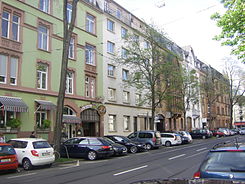Textorstrasse
| Textorstrasse | |
|---|---|
| Street in Frankfurt am Main | |
| The three cider taverns in Textorstraße are in the immediate vicinity: the Feuerrheel (No. 24, left), the Kanonesteppel (No. 20, middle) and the Germania (No. 16, right) | |
| Basic data | |
| place | Frankfurt am Main |
| District | Sachsenhausen |
| Created | as residential street 1899 |
| Hist. Names | Varrentrappstrasse |
| Connecting roads | Darmstädter Landstrasse (beginning), Holbeinstrasse (end) |
| Cross streets | Martin-May-Strasse, David-Stempel-Strasse, Bruchstrasse, Brückenstrasse, Stegstrasse, Diesterwegstrasse, Schweizer Strasse , Oppenheimer Landstrasse |
| Places | Adlhochplatz, Karl-Gerold-Platz |
| Buildings | former tram depot (No. 33), Textorbad (No. 42), Textor School (No. 102-104), Holbein School (No. 111) |


The Textorstraße is a street in the Frankfurt district of Sachsenhausen .
location
The street begins at number 40 on Darmstädter Landstrasse and runs in a west-southwest direction to number 51 on Holbeinstrasse , behind which it continues in a westerly direction as Thorwaldsenstrasse.
history
A provisional section of the Main-Neckar Railway ran over today's Textorstraße between the Mainspitze station and the Frankfurt local station . Opened in 1846, it is one of the first railways in Germany .
The street, which was laid out in the first half of the 19th century, was initially only built on in its eastern section and right at the beginning it housed Zimmer's quinine factory , which was based on the picturesque plan of Frankfurt am Main and the surrounding area drawn up by Friedrich Wilhelm Delkeskamp in 1864 can be seen (see illustration under the info box). The factory was located in the area between today's Darmstädter Landstrasse (in the east), Bruchstrasse (in the west), Hedderichstrasse (in the south) and Textorstrasse (in the north). Housing was also built on as the last section of the street.
The largely undeveloped in the 19th century road was in 1886 for the first time a name and was named after the Frankfurt physician and local politician Johann Georg Varrentrapp (1809-1886) Varrentrappstraße called.
When construction began in 1899, it was given its name, which is still valid today, of the Textor family (Latinized by Weber), which comes from Goethe's mother, just 13 years later .
The first residential building was built on the property with number 30 (corner of Bruchstrasse). By 1907 the street was almost completely built on with residential buildings, between which there were only two railway depots and two schools (Textor and Holbein School). The only undeveloped area was the site of the former quinine factory , which was not built on until the 1930s and contains three apartment blocks with a total of 256 residential units.
When it was first founded around the turn of the 19th and 20th centuries , the one kilometer long street was mainly inhabited by railway workers and merchants.
Transport links
The nearby S-Bahn stations local train station and Südbahnhof mean that Textorstraße is optimally connected to the Rhein-Main S-Bahn network. The latter station is also served by the A route of the Frankfurt U-Bahn (lines U1, U2, U3 and U8). In addition, tram lines 14, 15 and 16 and bus line 45 operate in the first section of Textorstraße (between Darmstädter Landstraße and Brückenstraße) , and they stop at Textorstraße and Brücken- / Textorstraße .
Special buildings
The serial killer Eugen Weidmann (1908–1939) lived in the house on Textorstrasse 69 before he murdered six people in Paris in 1937 . He was executed in 1939; his guillotine beheading was the last public execution in France .
In the late 1970s, the RAF maintained a conspiratorial apartment on Textorstrasse. The discovery of the one-room apartment on the ground floor of house number 79 led to the arrest of Rolf Heissler , who was one of the most wanted German terrorists at the time.
Individual evidence
- ^ A closer look at the book Sachsenhausen: Die Textorstraße by Jens-Holger Jensen, Günter Appel, Georg Becker, Frankfurt am Main, 2012, Editions Henrich, ISBN 978-3-921606-91-9
- ↑ FNP: News from the old Textorstrasse (article on the occasion of the above-mentioned book)
- ↑ FNP: Raster search brought drug trafficking to a standstill (Article of December 21, 2001)
- ^ FR: One revolver, one notebook, two passports (article from January 1, 2002)
- ↑ Der Spiegel: Terrorists: Squatting Inside (Article from June 18, 1979)
Web links
- The social structure of Textorstrasse In: LISA Science Portal Gerda Henkel Foundation from April 4, 2012.
- Georgios Chatzoudis: The title of 'District Historian ' is a door opener. An interview with the district historian and book author Jens Holger Jensen In: LISA Science Portal Gerda Henkel Foundation from April 27, 2012.
- Jens Holger Jensen: A closer look at Sachsenhausen In: LISA Science Portal Gerda Henkel Foundation from September 22, 2012.
